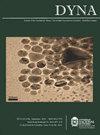逆向物流数学模型的比较:以农药容器与包装为例
Q3 Engineering
引用次数: 0
摘要
本文分析了混合整数线性规划(Mixed Integer Linear Programming, MILP)和离散事件模拟在逆向物流网络中的应用,具体应用于哥伦比亚boyac本文章由计算机程序翻译,如有差异,请以英文原文为准。
Comparison of mathematical models in reverse logistics: case of pesticide containers and packaging
This article presents an analysis of the use of Mixed Integer Linear Programming (MILP) and Discrete Event Simulation in reverse logistics networks, specifically applied to the process of collection and final disposal of empty pesticide containers and packaging in the Department of Boyacá- Colombia, which faces a problem due to the non-return and collection of all empty pesticide containers and packages generated by farmers. Due to the above, initially, a literature search on reverse logistics research is carried out, to subsequently propose a deterministic and stochastic model using linear programming and simulation respectively, to analyze which of these mathematical tools offers and represents better the process under study. The results show that the deterministic model offers better results in terms of planning the quantities to be collected in each of the farms, however, it does not contemplate the possible variations in different periods. On the contrary, the simulation, having a stochastic component, includes the variability of the generation of pesticide containers and packages, better identifying the bottlenecks that may occur in the process. In conclusion, it is evident that both models offer advantages for the reverse logistics process, where the ideal could be the combination of the deterministic with the stochastic.
求助全文
通过发布文献求助,成功后即可免费获取论文全文。
去求助
来源期刊

Dyna-Colombia
工程技术-工程:综合
CiteScore
1.30
自引率
0.00%
发文量
0
审稿时长
4-8 weeks
期刊介绍:
The DYNA journal, consistent with the aim of disseminating research in engineering, covers all disciplines within the large area of Engineering and Technology (OECD), through research articles, case studies and review articles resulting from work of national and international researchers.
 求助内容:
求助内容: 应助结果提醒方式:
应助结果提醒方式:


